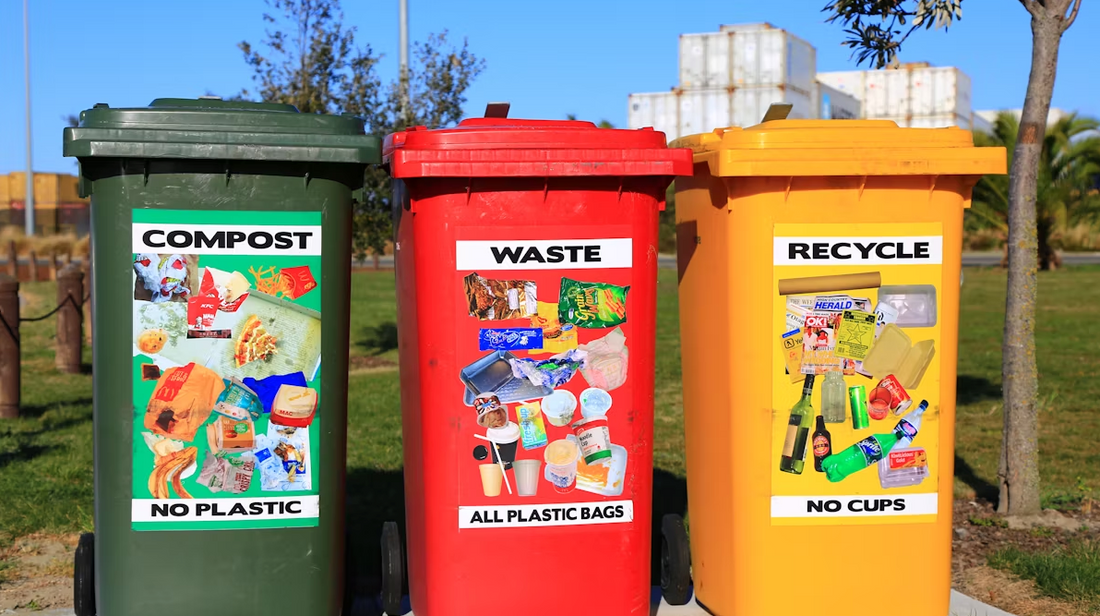
Wheelie Bins: Multipurpose Uses for Your Wheelie Bin
Introduction to the Versatility of Wheelie Bins
The wheelie bin, a ubiquitous sight in modern waste management, has a fascinating history and an array of practical uses. Originating in Britain in the early 1960s, the modern plastic wheelie bin revolutionised waste disposal, significantly reducing physical strain on both homeowners and garbage collectors. Its journey from a British innovation to a global phenomenon is a testament to its practicality.
Understanding the Design and Features
Wheelie bins are constructed from high-quality, UV-resistant polyethylene, ensuring durability and resilience against various weather conditions. Their robust design makes them essential for outdoor use while maintaining their structure and appearance over time. With distinctive colours providing easy recognition, they streamline waste disposal efforts by ensuring that recyclables, general waste, or specific materials are collected in the correct bin.
Materials and Durability
Wheelie bins are made from durable materials designed to withstand elements and maintain their integrity over time. This longevity sets them apart from traditional rubbish bags and ensures responsible waste disposal practices.
Capacity and Mobility
These heavy plastic boxes are rectangular in shape with two wheels on the underside for easy mobility. Their large capacity reduces the frequency of emptying compared to traditional rubbish bags, making them an efficient waste management solution.
Creative Uses for Wheelie Bins in Your Garden
Gardens are a haven for creativity, and repurposing wheelie bins can add both functionality and visual appeal to outdoor spaces. From composting to serving as unique planters, these versatile bins offer a range of possibilities for garden enthusiasts.
Transforming Wheelie Bins into Compost Bins
Repurposing a wheelie bin into a compost bin is an eco-friendly way to manage organic waste and enrich the soil in your garden. The process involves converting the bin into a receptacle for organic materials that will decompose over time, creating nutrient-rich compost.
Steps to Convert a Wheelie Bin
- Drill Ventilation Holes: Begin by drilling several holes in the sides and bottom of the wheelie bin to facilitate airflow, which is essential for the decomposition process.
- Layer Organic Materials: Add alternating layers of green (nitrogen-rich) and brown (carbon-rich) organic matter, such as kitchen scraps, yard waste, and shredded paper or cardboard.
- Turn the Compost: Regularly use a pitchfork or shovel to turn the compost within the bin, ensuring that oxygen reaches all parts of the mixture and accelerates decomposition.
Benefits of Wheelie Bin Composting
- Sustainable Waste Management: By diverting organic waste from landfills, wheelie bin composting reduces methane emissions while producing valuable fertiliser for gardens.
- Nutrient-Rich Soil Amendment: The resulting compost enriches garden soil with essential nutrients, improving its structure and promoting healthy plant growth.
Wheelie Bins as Planters
Wheelie bins can be repurposed as large-scale planters, adding an element of whimsy and functionality to any garden space. When used creatively, they provide ample room for growing various plants while contributing to sustainable gardening practices.
Choosing Plants for Your Wheelie Bin Planter
When selecting plants for your wheelie bin planter, consider options that thrive in contained environments and complement the size of the container. Herbs, compact vegetables like cherry tomatoes or peppers, and vibrant flowers are excellent choices for wheelie bin planters.
Preparing Your Wheelie Bin for Planting
- Drainage: Ensure proper drainage by drilling holes in the bottom of the bin to prevent water logging.
- Soil Selection: Fill the planter with high-quality potting mix suited to the specific needs of your chosen plants.
- Maintenance: Regular watering and occasional fertilisation will support healthy growth within the wheelie bin planter.
These innovative uses demonstrate how wheelie bins can be transformed into valuable assets within a garden setting while promoting sustainability through creative recycling initiatives.
Wheelie Bins as a Tool for Community Projects
Wheelie bins are not just limited to waste management; they can also serve as valuable tools for community projects, fostering a sense of environmental responsibility and collective action. From organising clean-up events to establishing community recycling programs, these versatile containers can play a pivotal role in promoting sustainability within local neighbourhoods.
Organising Community Clean-Up Events
Community clean-up events provide an opportunity for residents to come together and contribute to the cleanliness and aesthetics of their surroundings. Wheelie bins can be strategically utilised to streamline the collection and disposal of waste during such initiatives, ensuring an efficient and organised process.
Planning and Execution
When planning a community clean-up event, it is essential to assess the areas that require attention and allocate specific tasks to volunteers. Wheelie bins can be stationed at convenient intervals along the cleanup route, designated for different types of waste such as general rubbish, recyclables, and organic matter. This systematic approach simplifies waste collection and minimises the impact on the local environment.
Safety and Hygiene Considerations
Prioritising safety measures is crucial when involving the community in clean-up activities. Volunteers should be provided with appropriate protective gear such as gloves and sturdy footwear. Additionally, clear guidelines on proper waste disposal practices should be communicated to ensure the safe use of wheelie bins during the event.
Wheelie Bins for Collecting Recyclables
Establishing a community recycling programme is an effective way to promote sustainable practices while reducing the volume of waste destined for landfills. Wheelie bins can be repurposed as collection points for recyclable materials, encouraging residents to actively participate in environmentally conscious habits.
Setting Up a Community Recycling Programme
To initiate a successful community recycling programme, it is important to raise awareness about the importance of recycling and provide accessible collection points. By strategically positioning wheelie bins designated for specific types of recyclables such as paper, plastic, glass, and metal, communities can facilitate convenient recycling practices.
Educating the Community on Recycling Practices
Educational initiatives play a pivotal role in encouraging active participation in recycling efforts. Workshops, informational pamphlets, or online resources can be utilised to educate residents about proper sorting techniques and the significance of recycling. By empowering individuals with knowledge about sustainable waste management practices, communities can work collectively towards reducing their environmental footprint.
Unexpected Uses for Wheelie Bins in Daily Life
Wheelie bins are not just limited to waste management and gardening; they can also serve as versatile storage solutions and even provide opportunities for fun and games. Their sturdy construction and ample capacity make them ideal for various unexpected uses in daily life, adding value beyond their conventional purpose.
Wheelie Bins as Storage Solutions
Outdoor Equipment Storage
In outdoor settings, wheelie bins can be repurposed to store a wide range of equipment, keeping items organised and protected from the elements. From gardening tools to sports gear, these bins offer a convenient storage solution that helps maintain a clutter-free outdoor space.
When utilising wheelie bins for outdoor equipment storage, it is essential to ensure proper ventilation to prevent moisture build-up. Additionally, labelling the bins according to the stored items enhances accessibility and organisation.
Seasonal Item Storage
During off-season periods, such as winter or summer, wheelie bins can function as temporary storage units for seasonal items like decorations, clothing, or recreational gear. By repurposing these bins for seasonal storage needs, individuals can free up indoor space while safeguarding their belongings in a durable and weather-resistant container.
To optimise wheelie bin usage for seasonal item storage, it is advisable to clean and dry the bins thoroughly before storing items. Utilising additional protective covers or containers within the bin can further safeguard delicate or valuable seasonal items.
Fun and Games with Wheelie Bins
Wheelie Bin Races
Organising wheelie bin races can be an entertaining activity that promotes physical activity and friendly competition within communities or social gatherings. Participants can decorate their wheelie bins creatively and compete in races across designated courses, fostering camaraderie and lighthearted enjoyment.
When planning wheelie bin races, safety considerations should be prioritised to prevent accidents or injuries. Establishing clear race rules and guidelines ensures that participants engage in this activity responsibly while having an enjoyable experience.
DIY Obstacle Courses
Creating DIY obstacle courses using wheelie bins offers an opportunity for individuals of all ages to engage in physical challenges while enhancing agility and coordination. These courses can be designed with various obstacles such as weaving between strategically placed bins or incorporating jumping or balancing activities.
When setting up DIY obstacle courses with wheelie bins, it is important to ensure adequate spacing between obstacles to prevent collisions or tripping hazards. Clear instructions on navigating the course safely contribute to a positive experience for participants.
Conclusion: Reflecting on the Multipurpose Nature of Wheelie Bins
The Impact of Creative Reuse
The wheelie bin's journey from a simple idea to a global standard in waste management is a story of innovation and practicality. Its versatility extends beyond traditional waste disposal, offering an array of creative reuse opportunities that contribute to environmental sustainability and community engagement.
Environmental Benefits
The longevity and hygiene benefits of wheelie bins contribute to environmental and community benefits, encouraging sustainability. By repurposing these durable containers for activities such as composting, gardening, and storage, individuals can actively participate in reducing their environmental footprint. The eco-friendly practices associated with wheelie bin reuse align with the principles of responsible waste management and conservation.
Community Engagement
The wheelie bin serves as a symbol of efficient and hygienic waste management, designed to be sealed to contain odours and reduce the risk of pests and vermin. Through community projects such as clean-up events and recycling programmes, these versatile containers foster a sense of environmental responsibility among residents. The collaborative efforts facilitated by wheelie bins promote community engagement while addressing local environmental concerns.
Encouraging Further Innovation
The wheelie bin's multifaceted nature encourages further innovation in sustainable waste management practices. Sharing ideas and success stories related to creative wheelie bin reuse initiatives can inspire others to explore new possibilities for these versatile containers.
Sharing Ideas and Success Stories
By sharing experiences and innovative applications of wheelie bins, individuals can inspire others to embrace sustainable practices within their own communities. Success stories involving the transformation of wheelie bins into composting units, planters, or storage solutions serve as valuable examples that encourage widespread adoption of eco-friendly initiatives.
The Future of Wheelie Bins
As society continues to prioritise sustainability, the future holds promising opportunities for the continued evolution of wheelie bins as multipurpose assets. Innovations in material technology, design enhancements for specific uses, and educational campaigns promoting responsible reuse are poised to shape the next chapter in the legacy of these versatile containers.
